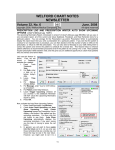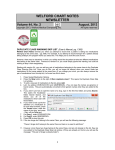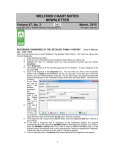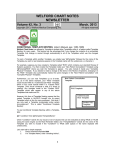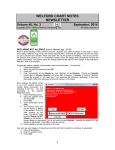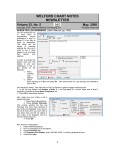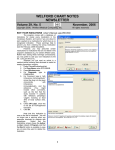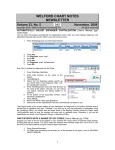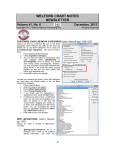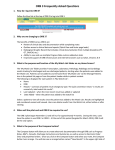Download March - MEDCOM Information Systems
Transcript
WELFORD CHART NOTES NEWSLETTER Volume 45, No. 3 March, 2014 copyright 2014, Welford Medical Computing, Inc. All rights reserved CROSS-REACTING ALLERGIES SKIP LIST (User's Manual, pages 1322-1325) Cross-Reacting Allergies are situations in which the patient is allergic to a medication in one class (for example, penicillin) which puts the patient at higher risk for an allergy to a medication in a different class (for example, cephalosporins). The program comes with a library of known cross-reacting allergies to which you can add your own (User's Manual, pages 843-845). However, what if you have a patient who is known to be allergic to one of these drugs, but has been safely taking the cross-reacting drug and thus is not allergic to it? You can now tell the program to stop warning you about the cross-reacting allergy for this particular patient. Let's see how this is done: 1. 2. 3. 4. 5. 6. 7. Press Libraries\Cross-Reacting Allergies\Skip\Edit. For Drug 1, enter one of the drugs in the pair of cross-reacting allergies (for example PENICILLINS). For Drug 2, enter the other drug in the pair of cross-reacting allergies (for example CEPHALOSPORINS). (Note that if the cross-reacting allergy applies to an entire Class of medications, enter the name of that class. If it only applies to a specific medication rather than the entire Class, enter the name of that specific medication). For Patient, enter the name of the patient for whom you no longer wish to see a warning about this cross-reacting allergy. (If you feel that this CrossReacting Allergy is no longer valid for any patient, and thus disagree with the Program Cross-Reacting Allergy for this pair of drugs, set the Patient to ANY). For User: if you are the only user who wishes to skip seeing the warning about this cross-reacting allergy, leave User set to your own name. However, if you would like to prevent all users at your site from seeing this particular combination of cross-reacting allergies (either for this Patient, or for All patients, depending on how you set the Patient field), then press the All button to apply this to all users. Enter an optional Comment about why you feel this cross-reacting allergy should be skipped. Press OK to store this information. Note that the program records at the bottom of the window the name of the user who added this to the list of cross-reacting skipped allergies, as well as the date and time that it took effect. Now, let's see how this item appears on the Cross-Reacting Allergies Skip List: 1. Press Libraries\Cross-Reacting Allergies\Skip\List. 6 2. 3. 4. 5. 6. You can see the item you just added on this list. If you wish to change something about this item, doubleclick it, or highlight it and press Edit. If you wish to delete it from the list altogether, press the Delete button. The list will then show you the date and time upon which the entry was deleted and thus no longer was active. If you wish to see just a portion of the entire Cross-Reacting Allergies Skip List, press Redisplay. On the redisplay screen, you can limit the display over a range of time, or for a particular patient, or for a particular medication. You can also choose whether or not to display Deleted items. . Note that you can also add an item to the Cross-Reacting Allergies Skip List at the time when you see one of these warnings. Simply press Skip from the warning window to open the Cross-Reacting Allergies Skip List Editor and add it to the list of skipped warnings. Using this feature helps you to avoid wasting time seeing warnings which do not apply to a particular patient and thus avoid alert fatigue. NEWS ON VERSION 6.6 We are hard at work on version 6.6. It includes a Cardiovascular Risk Calculator and Algorithm which allow you to follow the new guidelines for treating hyperlipidemia released in November, 2013 from the American College of Cardiology and American Heart Association. If there are particular features you would like to see in version 6.5, please contact us. SEND US YOUR TIPS If you have tips, shortcuts, questions, or suggestions for future newsletter topics, please send them to us at: Welford Medical Computing, Inc. or MEDCOM Information Systems 3779 Hermitage Trail 2117 Stonington Avenue Rockford, IL 6111 Hoffman Estates, IL 60195 7


